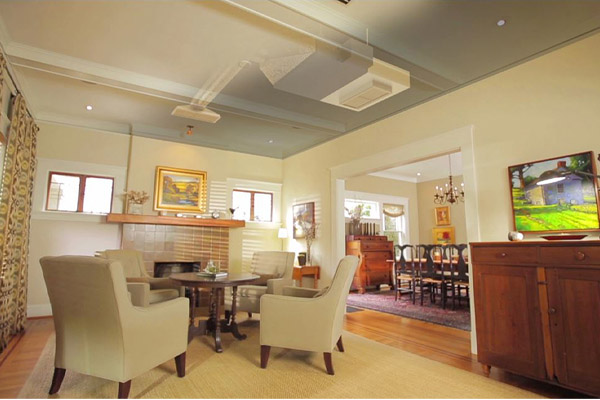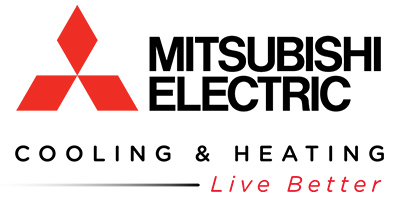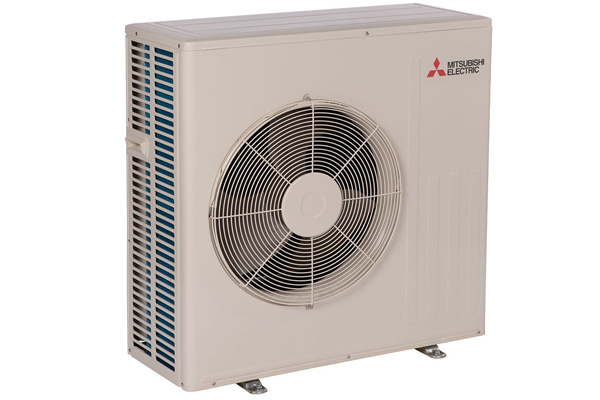
Wall-mounted ductless systems are the top choice among homeowners who prefer a mini-split system for their home. However, since HVAC contractors place wall-mounted systems on the walls, many homeowners are not fans of having to deal with an exposed component. Good thing they do have an alternative – a type of concealed duct mini-split system that is discreet.
The concealed duct mini-split is a near-invisible system. Like other ductless systems, it offers zoned heating and cooling. However, concealed duct systems provide a feature that many ductless counterparts cannot. They allow homeowners to enjoy an HVAC solution that does not have a bulky component that is so visible on the walls.
The major components of the indoor air handler are all concealed behind a dropped ceiling or in an attic or crawl space. The system pushes conditioned air through the ductwork before it distributes it to different zones via the grilles on the floor, ceiling, or walls.
Concealed Duct Mini-Split Systems: What You Need To Know
A concealed duct has different parts that work together to allow the system to work correctly.
Indoor Unit
- Indoor power supply- directs the supply of power to the indoor unit
- Diffusers– the part that distributes conditioned air to the room or zone
- Communication cable- serves as the connection between the indoor and the outdoor units
- Flexible ducts- distribute the conditioned air to different diffusers
- Return air grilles- filter the air to eliminate dust and similar particulates
- Motorized dampers- provide zoning capability
- Wired tether controller- serves as the controller of the indoor unit
Accessories Of The Ductless Indoor Unit
- Hanger- provides support to the unit
- Nut & washer- fasten the unit to the hanger brackets
- Nut- utilized for the installation of the unit; often used with a suspension bolt
- Washer- also used with the nut and suspension bolt
- Pipe insulation- provides insulation for the liquid and gas pipes
- Flare nut- serves to connect the gas and liquid pipes
- Fastener- keeps the insulation blanket in place
Outdoor Compressor
- Front panel- is in front of the compressor and covers the outdoor unit and its mechanisms
- Service cover- conceals the lines that connect the outdoor unit
- Gas pipe- distributes the refrigerant in gas form
- Liquid pipe- circulates the coolant in liquid form
- Drain hose- the hose where the condensate travels for disposal
- Outdoor power supply- provides power to the outdoor unit
Accessories For The Outdoor Unit
- Drain plug- plugs up the drain hole to prevent fluid from escaping
- Drainage connector- acts as a connection to the PVC drain pipe
Concealed Duct Features

Many homeowners appreciate the fact that you cannot see concealed ducts and, also, that they allow you excellent control over your indoor climate. With this system, the system pushes through conditioned air through the ductwork. Then, it releases the air to a room or zone via a grille on the ceiling or wall. This feature offers flexibility in choosing a certain grille type or style that will suit individual zones best.
Some of the most essential features of a concealed duct include:
Low Profile
An HVAC contractor can install a concealed duct system below or above its zone using short-run ductwork. The rest of the system is out of sight. The only visible component is a small grille. With a concealed duct, you can remain comfortable without worrying about the appearance of your indoor space.
Quiet Operation
The indoor air handlers of the concealed duct system work quietly. You never have to worry about having to deal with annoying noises from the HVAC system as you live, work, and perform other activities in your home.
Automatic Changes
You can set a concealed duct system to automatic mode. In this setting, the system can transition from heating to cooling and back again in just a few clicks. As a result, you can control your HVAC systems and enjoy even temperatures in every zone.
Comfort Control
It is possible to enhance the function of a concealed duct system through the addition of accessories. These will help you maximize comfort and enjoy better control. For example, you could use a temperature sensor that adjusts the settings on the system if there are fluctuations in the temperature within the zone. With this feature, you can always rely on your system to provide consistent comfort.
Remote Control
Some concealed duct models can be controlled via a remote control that matches your lifestyle. For example, you could use a wall-mounted remote controller that can be controlled using a smartphone or tablet app. If you travel a lot, are often away from home, or are planning to go on vacation, you can control the settings on your HVAC system remotely, from virtually anywhere using the app. That way, you always go home to a warm and comfortable house.
Other Features
There are optional features that you might consider for your concealed duct system. These features will depend on the type, make, model, and brand of the system you choose. These include:
- Provision for fresh air intake
- External static pressure (adjustable)
- Anti-cold air function
- Refrigerant leakage detector
- Convertible return-air provision
- Drain pump and float switch
Is A Concealed Duct System Right For You?
If you prefer an HVAC system that is hidden from view, the concealed duct is the right choice for your home. This type of system can be installed behind the ceiling or the floor, with only grilles visible. Concealed ducts are excellent for helping maintain aesthetic value, especially if this is a priority.
Concealed duct systems have high-efficiency ducts that distribute conditioned air evenly, regardless of the size of the room or space. Conditioned air is pushed through short-run ducts that connect to several outlets in a room. Concealed ducts are also perfect for cooling or heating a smaller, adjacent room. If you have existing ductwork and wish to avoid modifying an old, inefficient system, consider a concealed duct system for your home.
A key feature of concealed mini-split units is that these are effective in heating or cooling living spaces that other types of HVAC systems can’t. These include basements, sunrooms, new additions, and historic homes.

Getting A Concealed Duct Unit Installed
Concealed ducts are flexible enough to be installed virtually anywhere. However, for the purpose of safety and accessibility, some of the most common spaces where concealed ducts are installed include areas such as the attic or a crawlspace. These spots have to be well-insulated to protect the unit and prevent leaks. If the installation area does not have the proper insulation, your option is to have a box built to contain the unit. This will provide insulation for its exterior and help prevent the formation of condensate.
If your existing ducts are currently in use for distributing conditioned air in the same room albeit through different locations, have transition ducts installed. It is also a good idea to get an outlet grilles. You should also consider installing air filters if you plan to install return air vents to collect dust, dander, and other particulates.
The ceiling on which a concealed duct will be installed should be sturdy enough to hold twice the unit’s weight. There should also be sufficient space to allow easy access to the unit in case of service and maintenance work. The air outlet and inlet components should also be unobstructed to allow proper airflow. If the outlets are blocked, air will not be distributed evenly.
If you intend to install the concealed duct unit on a wall surface, ducting may not be required. Grilles, however, protect the unit and give it a finished look.
Check Out One Of Our Ductless Installation Projects
Mitsubishi Ductless Installation Project In Rocky Hill, New Jersey
Conclusion
Concealed ducts offer an excellent means to enjoy the setup of a ducted system with the added aesthetic value that you can’t always get from other types of HVAC systems. Furthermore, this option allows you to enjoy high-efficiency, zoning capabilities, and quiet operation.
To ensure that you enjoy the highest quality experience with your concealed duct system, hire only a professional HVAC company to install the unit. A trained and experienced technician can assure you of safe and accurate installation work that meets local and state codes. With an HVAC expert, you can also ensure that your concealed duct system will perform excellently for many years.
Call PFO Heating & Air Conditioning To Learn More About Ductless HVAC Systems

For all your HVAC system needs, call PFO Heating & Air Conditioning today. Our technicians are all NATE-certified, and they have a great deal of experience. They’ll also determine what your home comfort needs are and find the best and most affordable solutions to meet them.
As a full-service HVAC company, PFO Heating & Air Conditioning offers an array of HVAC services. This includes heating and cooling installations, tuneups, repairs, and much more. We offer free, in-home consultations. Call now to schedule an appointment.
Click here to contact us now or call us at (800) 253-9001 to find out more!
The post Why A Concealed Duct Mini-Split System Is Perfect For Your Home appeared first on PFO Heating & Air Conditioning.
from PFO Heating & Air Conditioning https://www.princetonfuel.com/blog/concealed-duct-mini-split/?utm_source=rss&utm_medium=rss&utm_campaign=concealed-duct-mini-split
via IFTTT
No comments:
Post a Comment